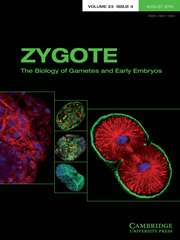Article contents
Aggregation of cloned embryos in empty zona pellucida improves derivation efficiency of pig ES-like cells
Published online by Cambridge University Press: 03 October 2016
Summary
The development of embryonic stem cells (ESCs) from large animal species has become an important model for therapeutic cloning using ESCs derived by somatic cell nuclear transfer (SCNT). However, poor embryo quality and blastocyst formation have been major limitations for derivation of cloned ESCs (ntESCs). In this study, we have tried to overcome these problems by treating these cells with histone deacetylase inhibitors (HDACi) and aggregating porcine embryos. First, cloned embryos were treated with Scriptaid to confirm the effect of HDACi on cloned embryo quality. The Scriptaid-treated blastocysts showed significantly higher total cell numbers (29.50 ± 2.10) than non-treated blastocysts (22.29 ± 1.50, P < 0.05). Next, cloned embryo quality and blastocyst formation were analyzed in aggregates. Three zona-free, reconstructed, four-cell-stage SCNT embryos were injected into the empty zona of hatched parthenogenetic (PA) blastocysts. Blastocyst formation and total cell number of cloned blastocysts increased significantly for all aggregates (76.4% and 83.18 ± 8.33) compared with non-aggregates (25.5% and 27.11 ± 1.67, P < 0.05). Finally, aggregated blastocysts were cultured on a feeder layer to examine the efficiency of porcine ES-like cell derivation. Aggregated blastocysts showed a higher primary colony formation rate than non-aggregated cloned blastocysts (17.6 ± 12.3% vs. 2.2 ± 1.35%, respectively, P < 0.05). In addition, derived ES-like cells showed typical characters of ESCs. In conclusion, the aggregation of porcine SCNT embryos at the four-cell stage could be a useful technique for improving the development rate and quality of porcine-cloned blastocysts and the derivation efficiency of porcine ntESCs.
- Type
- Research Article
- Information
- Copyright
- Copyright © Cambridge University Press 2016
References
- 7
- Cited by


